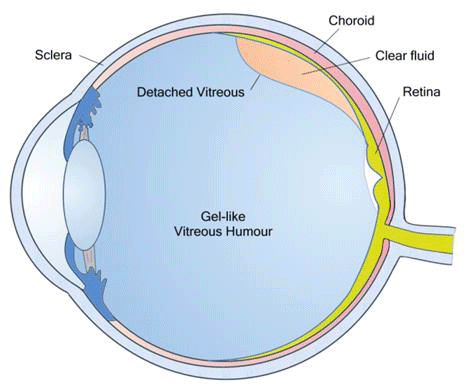


Joseph R. Anticaglia MD
Medical Advisory Board
We recognize people and the world around us when light passes into the eye, travels across the vitreous material of the eye on its way to the retina. The vitreous is a clear, jelly-like substance that occupies about 80% of the space within the eye and is normally attached to the retina. The retina has light sensitive nerve cells in the back of the eye that relays signals to the brain so we can see.
The vitreous is composed of about 99% water and 1% collagen and hyaluronic acid. It has several functions:
A posterior vitreous detachment (PVD) occurs when the vitreous separates from the retina. PVD is a frequent process of aging and it is more prevalent the closer you get to 70 years of age. Most people with a PVD are not aware of any symptoms. Others see floaters and flashes of light.
The vitreous is attached to the retina by millions of fibers. As we get older, the fibers become weaker and the vitreous shrinks in size. This bothersome combination can lead to PVD and the more dangerous tear in the retina. If you have floaters and flashes of light, especially with a loss of vision, make an appointment to see your ophthalmologist immediately to prevent a permanent loss of vision.

Mildred is a 63 year old woman who noticed the sudden appearance of dots and “wavy hairs” in her left eye. A few hours later, she noticed flashes of light in that eye which temporarily interfered with her ability to work on the computer.
She telephoned her ophthalmologist who asked, “Do you have any difficulty with your vision, such as, a dark curtain blocking your vision or shadows in the side of your vision? Have you had any trauma to the eye? Do you have migraine headaches?” Do you have diabetes?
When Mildred answered no to the questions, the doctor continued, “I don’t think this is serious but I want you to see my colleague expeditiously. She’s a retinal specialist and it’s important to rule out a retinal detachment which is a serious problem.”
That same day, Mildred was in the specialist’s office. She performed the eye examination and said, “There is no retinal tear or retinal detachment. Your problem involves the vitreous which is moving itself away from the retina in the back of the eye. When this movement occurs, you and other patients can experience flashes of light and the sensation that things are floating around in the eye.”
She continued, “After middle age and as we get older, the vitreous becomes more watery and shrinks in size forming clumps of cells that float inside the vitreous. These cells cast shadows on the retina which we perceive as floaters.
At times, the vitreous detaches itself from the retina a situation that doctors call posterior vitreous detachment (PVD). In so doing, it might create tiny tears of the retina forming new floaters. Once again, you have no problem with the retina. Floaters can look like squiggly hairs, circles, dots, specks or cobwebs. Ordinarily floaters become less noticeable with time and no treatment is indicated.” The doctor concluded, “What’s important is to have a thorough eye examination to make sure the retina is healthy. A damaged retina can cause a permanent loss of vision.”
With flashes, the vitreous gel rubs or pulls on the retina in the back of the eye. This tugging on the retina causes electrical signals to be sent to the brain that we interpret as being flashes of light or streaks of lightening. Flashes may be noticeable for several weeks or months. When the vitreous comes away from the retina, the symptoms usually go away.
Migraine headaches can cause flashes. Also, trauma to the eye can cause flashes or floaters. Of paramount concern is when floaters or flashes is caused by a retinal detachment; this condition is an emergency requiring immediate attention.
Some of the symptoms of PVD are similar to a retinal detachment.
Floaters and flashes are common as you get older and you’re more likely to have them if you have diabetes, if you’re nearsighted or have had cataract surgery. They usually require no treatment, but if you have these symptoms or other warning signs of a retinal detachment, you should see your ophthalmologist “expeditiously.”
This article is intended solely as a learning experience. Please consult your physician for diagnostic and treatment options.